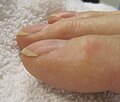Finger clubbing
Nail clubbing, also known as digital clubbing, is a deformity of the finger or toe nails associated with a number of diseases, mostly of the heart and lungs.[2][3] Clubbing for no obvious reason can also occur, but is rare.[4][5] Hippocrateswas probably the first to document clubbing as a sign of disease, and the phenomenon is therefore occasionally called Hippocratic fingers.
DetectionEdit
Clubbing may be present in one of five stages:[6]
No visible clubbing. Fluctuation (increased ballotability) and softening of the nail bed only. No visible changes of nails.Mild clubbing. Loss of the normal <165° angle (Lovibond angle) between the nailbed and the fold (cuticula). Schamroth's window is obliterated. Clubbing is not obvious at a glance.Moderate clubbing. Increased convexity of the nail fold. Clubbing is apparent at a glance.Gross clubbing. Thickening of the whole distal (end part of the) finger (resembling a drumstick)Hypertrophic osteoarthropathy. Shiny aspect and striation of the nail and skin
Schamroth's test or Schamroth's window test (originally demonstrated by South African cardiologist Leo Schamroth on himself)[7] is a popular test for clubbing. When the distal phalanges (bones nearest the fingertips) of corresponding fingers of opposite hands are directly opposed (place fingernails of same finger on opposite hands against each other, nail to nail), a small diamond-shaped "window" is normally apparent between the nailbeds. If this window is obliterated, the test is positive and clubbing is present.
Severe clubbing
Front view
Side views
CausesEdit
Although many diseases are associated with clubbing (particularly lung diseases), the reports are fairly anecdotal. Prospective studies of patients presenting with clubbing have not yet been performed, and hence there is no conclusive evidence of these associations.
Isolated clubbingEdit
Clubbing is associated with:
Lung disease:Lung cancer, mainly non-small-cell (54% of all cases), not seen frequently in small-cell lung cancer (< 5% of cases)[8]Interstitial lung disease most commonly fibrosing alveolitisComplicated tuberculosisSuppurative lung disease: lung abscess, empyema, bronchiectasis, cystic fibrosisMesothelioma of the pleuraArteriovenous fistula or malformationHeart disease:Any disease featuring chronic hypoxiaCongenital cyanotic heart disease(most common cardiac cause)Subacute bacterial endocarditisAtrial myxoma (benign tumor)Tetralogy of FallotGastrointestinal and hepatobiliary:MalabsorptionCrohn's disease and ulcerative colitisCirrhosis, especially in primary biliary cirrhosis[9]Hepatopulmonary syndrome, a complication of cirrhosis[10]Others:Graves' disease (autoimmune hyperthyroidism) – in this case it is known as thyroid acropachy[11]Familial and racial clubbing and "pseudoclubbing" (people of African descent often have what appears to be clubbing)Vascular anomalies of the affected arm such as an axillary artery aneurysm (in unilateral clubbing)
Nail clubbing is not specific to chronic obstructive pulmonary disease (COPD). Therefore, in patients with COPD with significant degrees of clubbing, a search for signs of bronchogenic carcinoma (or other causes of clubbing) might be indicated.[6]
A congenital form is also known.[12] This may be inherited either in an autosomal recessive or dominant fashion. In these cases the thumbs are almost always affected: the other fingers may be affected.










Post a Comment